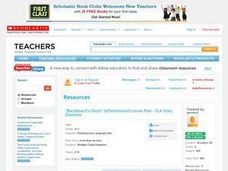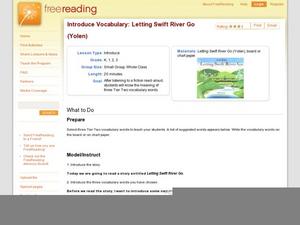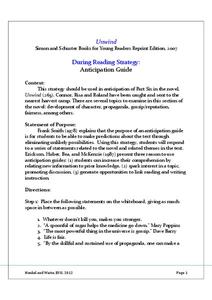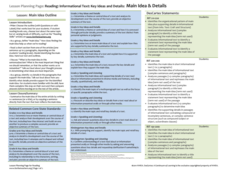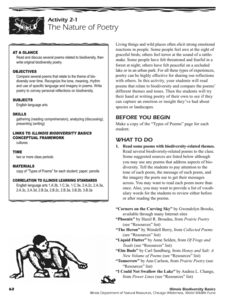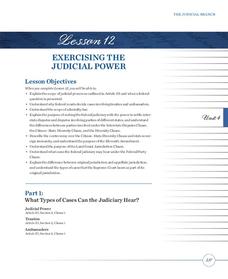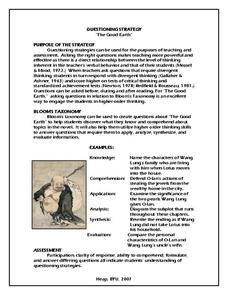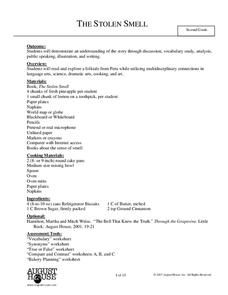Curated OER
Is That Movie OK?
Discuss movies and movie enjoyment with your middle school language arts class. They interpret movie review information, determine appropriate movies, and then write film reviews to share with the class. Focus on using context clues to...
Curated OER
"Blackbeard's Ghost" Differentiated Lesson Plan
Develop a better understanding of "Blackbeard's Ghost" with this differentiated lesson. Working in groups on a creative project, middle schoolers can reinforce their reading comprehension and literary analysis skills. Use this...
Curated OER
Pride and Prejudice: Question Answer Relationship Strategy
Help middle and high school readers access the text with a series of question-answer relationship (QAR) strategies. Using Jane Austen's Pride and Prejudice as an example, the resource prompts learners to ask and answer questions using...
Curated OER
Speak: Questioning Strategy - ReQuest Strategy
The best way to analyze a piece of literature is to ask questions about the characters, plot, and theme. Encourage your learners to stump the teacher with the most difficult questions they can create using Bloom's Taxonomy and various...
Curated OER
Shizuko’s Daughter: Story Impression
Craft your own fairy tale based on Momotaro, a Japanese story referenced in Kyoko Mori's Shuzuko's Daughter. A list of nouns guide learners in writing their own story, and predicting what might happen in the novel.
Novelinks
The Good Earth: Vocabulary Bingo Strategy
Endeavor. Qualm. Stolid. Fortitude. Filial. Bingo! As part of their study of Pearl Buck's The Good Earth, class members engage in a vocabulary bingo game.
Curated OER
Introduce Vocabulary: Letting Swift River Go (Yolen)
If your class is reading Jane Yolen's Letting Swift River Go, explore these vocabulary words in context: faint, quench, remain, and sacred. Before reading the story aloud, acquaint learners with these words briefly....
Curated OER
The Glass Menagerie: Anticipation Guide
Readers are introduced to the key themes in Tennessee Williams' The Glass Menagerie by this carefully crafted anticipation guide. A great discussion starter.
Missouri Department of Elementary
An Apple a Day
Three apples—green, red, and rotten—exemplify character traits, negative and positive. Following a discussion about the classroom community, scholars complete an apple-themed worksheet that challenges them to read each trait, color it...
Curated OER
Twelfth Night: The K-W-H-L Strategy
Readers of Twelfth Night use a KWHL chart to record information about what they know about Shakespeare's play, what they want to find out, how they plan on finding this information, and what they have learned or still want to learn about...
Curated OER
Unwind: Anticipation Guide
After responding to a series of prompts on an anticipation guide, readers of Unwind craft five predictions about what will happen in Neal Shusterman's young adult science fiction novel.
Curated OER
Keywords: A Memorization Strategy
Here is a fabulous, five-page lesson plan on how keywords can help a reader with his/her reading comprehension. After a teacher-led discussion, pupils pair off with each other and work together to identify the main idea in a passage of...
For the Teachers
Main Idea Outline
Find the main idea in an informational text with a versatile lesson. Three levels of differentiation help you implement the strategy in any age or class level, based on the ability and objectives of your learners.
Illinois Department of Natural Resources
Section Two: Why is Biodiversity Important?
Explore soil, genetic traits, natural resources, and pollution in a series of lessons that focus on biodiversity. Kids complete experiments to learn more about the importance of varied genes and organisms in an ecosystem.
Harper Collins
Parrot in the Oven: Response Journal
After completing Chapter 5 of Parrot in the Oven: Mi Vida, readers make text-to-self, text-to-text, and text-to-world connections to Victor Martinez's novel by crafting journal entries addressing comments and questions to characters in...
Novelinks
The Good Earth: Biopoem Strategy
To gain a better understanding of characters in Pearl Buck's The Good Earth, kids create a biopoem for one of her characters.
Heritage Foundation
The Powers of the Executive
Are executives as powerful as they sound? High schoolers find out about the US president and executive branch. A variety of activities include scaffolded reading sections, research assignments, and collaborative group work.
Heritage Foundation
Exercising Judicial Power
We should all do more exercising, but should the judicial branch as well? High schoolers develop their understanding of what powers the judicial branch carries because of the US Constitution, as well as where their limits lie in the...
Novelinks
The Good Earth: Questioning Strategy
Readers use Bloom's Taxonomy to create multi-level questions about Pearl Buck's The Good Earth.
Curated OER
Deck the Halls with Literature Trees
Reinforce and assess reading comprehension by having your class make a literature tree! After reading a book, pupils make decorations to represent the book's themes, characters, and setting. Materials for decorating can be as diverse and...
Novelinks
Sense and Sensibility: Anticipation Guide Reading Strategy
Begin your discussion about Jane Austen's Sense and Sensibility before you even open the book. Kids fill in a worksheet that lists five statements about the literary themes of the novel, and then discuss their opinions as a...
Society for Science & the Public
Easter Islanders Made Tools, Not War
When studying artifacts, especially tools, how do archaeologists determine what the devices were used for? In what ways might researchers' previous experiences influence their perception of an artifact? An article about researchers'...
Nemours KidsHealth
Online Safety: Grades 6-8
Recognize risky behaviors and avoid them! That's the big idea behind two activities designed to teach middle schoolers to think critically about online safety. After reading background articles about protecting online identity,...
Curated OER
The Stolen Smell
Second graders read the story The Stolen Smell and participate in many language arts based activity connected to the story. They participate in discussions, vocabulary work, analyzing the story, public speaking, illustrating pictures,...

